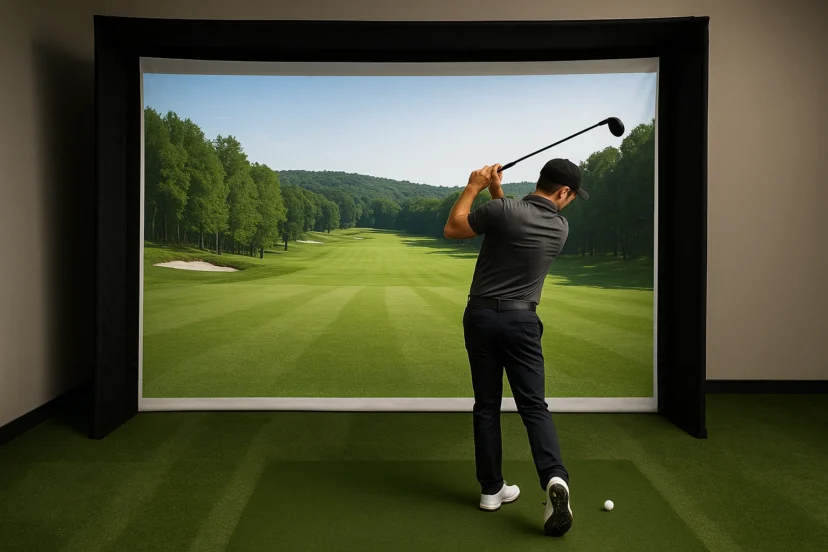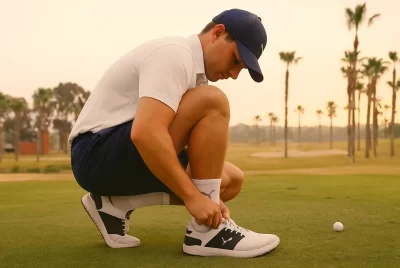Ultimate Guide to Golf Impact Screen
*We may earn a commission for purchases made using our links. Please see our disclosure to learn more.
As an avid golfer who struggled with maintaining consistent practice during Minnesota’s brutal winters, discovering golf impact screens was nothing short of revolutionary for my game. That first solid thwack of a 7-iron against my newly installed impact screen in my garage instantly transformed my relationship with off-season practice. No longer would my swing deteriorate for months at a time – I had found the solution to year-round improvement.
Golf impact screens represent the heart of any home golf simulator setup. These specialized fabric screens capture your real golf balls while displaying your shot data and virtual courses through projection. Whether you’re looking to sharpen your skills during the off-season, analyze your swing mechanics, or simply enjoy a round with friends regardless of weather, a quality impact screen is the foundation of the experience.
In this comprehensive guide, I’ll walk you through everything I’ve learned about selecting, installing, and maximizing the potential of golf impact screens. From budget-friendly options to professional-grade setups, I’ll help you navigate the considerations that will transform your garage, basement, or spare room into your personal golf sanctuary.
Key Takeaways
- Golf impact screens allow you to practice your full swing at home with real-time feedback
- Quality materials and proper installation are crucial for durability and performance
- Consider your space dimensions and budget before purchasing
- The right projector and launch monitor pairing can create a professional-level home simulator
“The ability to practice with immediate feedback accelerates improvement more than any other factor in golf training.”
– David Leadbetter, World-renowned Golf Instructor
Top 4 Golf Impact Screens
aikeec Golf Simulator Impact Screen
Transform your home or garage into a professional-grade golf simulator with the aikeec Golf Simulator Impact Screen. Designed with durability and performance in mind, this impact screen is built to withstand high-speed golf ball impacts and deliver a superior, immersive practice experience. Featuring a reinforced 7mm edge and 5mm thick polyester construction, the screen reduces noise and provides a stable, secure setup for any golf simulator system. Whether you're training indoors or in your garage, this screen ensures optimal visuals and lasting performance.
Crafted from durable, commercial-grade polyester, the aikeec Golf Simulator Impact Screen offers exceptional ball impact resistance while delivering high-definition image quality for an immersive golfing experience. Designed to handle high-speed golf balls, it ensures long-lasting performance and a quiet impact.
- Superior Durability: Withstands golf balls traveling up to 200mph, tested for 100,000 strokes.
- Quiet Impact: Reduced noise upon ball contact for a peaceful practice environment.
- Versatile Setup: Easy installation with 32-46 grommets, compatible with various mounting methods.
- Size Variations: Larger screen options may be more expensive.
- Requires Mounting: Wall-mounting is necessary, requiring space and equipment.
- Potential Sagging: Larger sizes may require additional support to avoid sagging over time.
GoSports Golf Simulator Impact Screen
The GoSports Golf Simulator Impact Screen provides an excellent solution for golf enthusiasts looking to elevate their indoor practice setup. Made from high-density woven polyester, it’s built to handle real golf ball impacts while providing a high-definition backdrop for your simulator or projector. The screen features 4 corner grommets for easy mounting and can be used with the GoSports ELITE Golf Net for a complete simulator experience. Whether you're perfecting your swing or enjoying a family movie night, this versatile screen delivers quality performance for all your needs.
The GoSports Golf Simulator Impact Screen is designed to provide an exceptional golfing experience with its excellent noise reduction features and high-definition projection surface. Crafted from high-density woven polyester, the screen effectively absorbs the impact of real golf balls, minimizing sound and vibrations for a quieter, more peaceful practice session.
- Durable Construction: High-density woven polyester material withstands real golf ball impacts.
- HD Picture Quality: Provides crisp, detailed visuals for golf simulators and movie nights.
- Universal Mounting: Easy to install with grommets or seamlessly connects with GoSports ELITE Golf Net.
- No Projector Included: Screen only, golf simulator setup requires additional equipment.
- Size Limitations: Available in two sizes, may not fit all simulator setups.
- Requires Mounting: Wall-mounting needed for installation, adding to setup complexity.
COALA HOLA Golf Simulator Impact Screen
The COALA HOLA Golf Simulator Impact Screen is designed to deliver a premium golfing experience with its ultra-clear, 4mm thickened polyester fabric that ensures durability and excellent performance. Built with a 3D air mesh structure, this impact screen is engineered to absorb the impact of real golf balls traveling at speeds over 200 mph, resisting up to 100,000 strokes. It also features low noise impact technology, minimizing sound during your practice sessions for a quieter environment. Available in 8 different sizes, the screen is easy to install with 32 grommet holes, making it perfect for both indoor and outdoor use. Whether you're refining your swing or enjoying a family movie night, this versatile screen provides superior clarity and lasting durability.
The COALA HOLA Golf Simulator Impact Screen is designed for golfers who need a quick and hassle-free setup without compromising on durability. Made from premium ballistic-grade polyester material, it is built to withstand the toughest impacts from high-speed golf balls while providing excellent clarity for a truly immersive experience. The advanced 3D air mesh structure not only ensures a long-lasting impact screen but also offers industry-leading durability, capable of resisting up to 100,000 strokes.
- Durable Construction: 4mm thickened, three-layer polyester structure withstands high-speed golf balls.
- Clear HD Projection: 3D air mesh fabric provides a high-definition, realistic display for golf simulators and home theater.
- Low Noise Impact: Reduces noise significantly for a quieter and more enjoyable practice environment.
- Requires Mounting: Installation requires securing the screen to a frame with ropes or bungee cords.
- Size Options: Larger sizes may be pricier, which could be a limitation for budget-conscious buyers.
- Setup Complexity: While easy to install, setting up in an outdoor environment may require additional support for stability.
Fahnemt Golf Simulator Impact Screen
The Fahnemt Golf Simulator Impact Screen is designed to provide an exceptional practice experience for golfers at all levels. Made from high-quality polyester, this impact screen features a double-knit design, with one side providing high-strength durability and the other ensuring a clear, high-definition display. The screen is built to withstand repeated high-impact shots, offering enhanced tear resistance and durability. It is perfect for both indoor and outdoor use, making it ideal for home or garage setups. The screen is easy to install and dismantle with simple hooks or stands, making it quick and convenient for any golfer. Available in multiple sizes, this versatile screen is perfect for not just golf, but also other ball sports, adding multi-sport functionality to your setup.
The Fahnemt Motorized Retractable Golf Simulator Impact Screen offers an innovative design that is ideal for golfers who need a high-quality, space-saving solution for their home or garage. This motorized screen easily retracts when not in use, making it perfect for multi-purpose spaces that need to serve other functions when you’re not practicing. The screen boasts a premium projection surface that ensures a crystal-clear and immersive golfing experience.
- Durable Construction: Double-knit design provides enhanced tear resistance, able to handle high-impact shots without breaking.
- Clear HD Projection: High-definition knit surface ensures sharp, clear visuals for golf simulation games and practice.
- Easy Setup: Quick and simple installation with hooks or stands, ideal for home, garage, or outdoor use.
- Requires Mounting: Needs hooks or stands for installation, which may not be included with the purchase.
- Limited Size Options: While sizes are available, larger options come at a higher price point.
- Washable, but Requires Care: While washable, the screen's longevity depends on proper cleaning and maintenance.
Understanding Golf Impact Screens: More Than Just Fabric
When I first decided to build my home simulator, I naively assumed any thick fabric would work as an impact screen. After tearing through a bed sheet and nearly damaging my garage wall with a particularly well-struck drive, I quickly learned that proper impact screens are engineered specifically for golf.
Golf impact screens are designed with specialized materials that serve multiple crucial functions:
Impact Resistance
Quality screens use ballistic-grade materials similar to those in bulletproof vests. These materials absorb the energy of golf balls traveling at speeds sometimes exceeding 150 mph without tearing or degrading quickly. My first professional screen has withstood thousands of shots with minimal wear after two years of regular use.
Projection Quality
The best screens feature a smooth, white surface that serves as an excellent projection medium. Higher-end models include specific coatings that enhance color accuracy and brightness, creating a more immersive simulation experience. When I upgraded from my entry-level screen to a premium model, the difference in image clarity was immediately noticeable – suddenly I could see subtle course details that made the experience significantly more realistic.
Sound Dampening
A good impact screen also reduces the sharp “crack” sound of ball impact to a softer thud, making your simulator more neighbor and family-friendly. This was particularly important in my semi-detached home, where sharing walls with neighbors meant noise consideration was essential.
Bounce-Back Control
Quality screens absorb energy to minimize ball rebound. Lower-quality options often send balls ricocheting back toward you at dangerous speeds. After experiencing a painful ricochet from my first budget screen that left a bruise on my thigh, I prioritized this feature in my upgrade.
Selecting the Right Impact Screen for Your Space
Space Considerations
Before purchasing any impact screen, I recommend carefully measuring your available space. My initial measurements failed to account for:
- Swing clearance: You’ll need enough room for your tallest player to swing a driver without hitting the ceiling
- Shot depth: Allow at least 8-10 feet from the hitting area to the screen
- Side clearance: Account for both right and left-handed players’ swings
- Ceiling height: Ideally 9+ feet, though I’ve made 8-foot ceilings work with adjusted swing planes
In my basement setup, I initially mounted the screen too close to my hitting position, resulting in uncomfortably quick ball returns and exaggerated ball marks on the screen. Moving the tee position back an additional two feet made a significant difference in both screen longevity and simulation experience.
Material Options
Impact screens come in various materials, each with distinct advantages:
- Polyester blend screens: Budget-friendly but less durable (3,000-10,000 hits)
- Commercial-grade impact fabric: Mid-range durability (15,000-30,000 hits)
- Ballistic nylon/impact mesh: Premium longevity (50,000+ hits)
I initially chose a mid-range commercial-grade screen which performed admirably for about 18 months of regular use before showing significant wear at my most common impact points. My current ballistic impact mesh screen has shown minimal wear despite more intense usage.
Screen Tensioning Systems
Proper tensioning is crucial for both projection quality and impact absorption. My first screen utilized simple grommets and bungee cords, which required frequent readjustment. My upgraded setup features:
- Integrated tensioning straps
- Corner reinforcement
- Adjustable mounting brackets
This system has maintained consistent tension through thousands of shots with minimal maintenance. The improved tensioning also significantly enhanced projection quality by eliminating wrinkles and screen movement.
Installation: Setting Yourself Up for Success
Framing Options
Your impact screen needs proper mounting to perform its best. Common framing approaches include:
- PVC pipe frames: Budget-friendly but less stable
- Metal conduit frames: Good balance of strength and affordability
- Aluminum structural frames: Premium stability and longevity
- Wood custom frames: Highly customizable to your space
My journey began with a PVC frame that, while functional, wobbled noticeably on harder shots. Upgrading to a metal conduit system eliminated this issue entirely. If I were starting over, I’d invest in the metal conduit system from the beginning to save the additional expense and effort of upgrading.
Mounting Techniques
Proper mounting significantly impacts screen performance. Consider:
- Edge reinforcement: Prevents tearing at attachment points
- Even tensioning: Eliminates wrinkles for better projection
- Slight curve: Improves ball containment and reduces bounce-back
I found that mounting my screen with a slight concave curve (about 4-5 inches of depth at center) dramatically improved ball containment and reduced the occasional wild ricochet that occurred with my completely flat initial installation.
Protective Backing
Always install protective backing behind your impact screen. Options include:
- Moving blankets: Affordable but limited durability
- Foam panels: Good balance of protection and sound dampening
- Commercial impact padding: Premium protection and longevity
After a particularly powerful drive somehow found a weak point in my screen and left a small dent in my wall, I upgraded from moving blankets to 2-inch foam panels. The difference was immediately noticeable – not just in protection, but in sound reduction that made the entire setup more pleasant to use.
Creating the Complete Simulator Experience
Projector Selection
Your projector significantly impacts the realism of your simulator. Consider:
- Throw ratio: Short-throw projectors work best in limited spaces
- Brightness (lumens): Higher brightness allows usage with some ambient light
- Resolution: HD or 4K provides more realistic course details
- Input lag: Lower lag creates more realistic ball flight synchronization
After starting with a budget 720p projector, upgrading to a short-throw 1080p model with higher brightness transformed my experience, allowing me to see subtle details like green contours that significantly improved my putting practice.
Launch Monitors
The launch monitor provides the data that makes your simulator functional. Options include:
- Photometric systems: Camera-based tracking (SkyTrak, Mevo+)
- Radar-based systems: Doppler radar tracking (Garmin, FlightScope)
- Premium commercial systems: Combining multiple technologies (GCQuad, Trackman)
My SkyTrak launch monitor has provided reliable data that has genuinely improved my game. The ability to see spin rates revealed a severe spin issue with my driver that, once corrected, added nearly 20 yards to my drives on the actual course.
Simulator Software
Different software packages offer varying features:
- Basic options: Simple driving range functionality
- Mid-range packages: Virtual courses with basic graphics
- Premium software: Photorealistic courses, detailed analytics, and online competition
E6 Connect has been my software of choice, offering a good balance of course selection, realistic graphics, and useful data analysis that helps me focus my practice sessions on specific weaknesses in my game.
Maximizing Your Impact Screen’s Lifespan
Proper Ball Selection
Not all golf balls are suitable for impact screens:
- Avoid range balls: Their harder composition can damage screens
- Use mid-compression balls: Better screen longevity
- Consider foam or limited-flight balls: For smaller spaces or beginners
After noticing accelerated wear when using range balls I’d collected, switching to mid-compression balls designed for simulators significantly reduced the wear rate on my screen.
Maintenance Practices
Regular maintenance extends screen life:
- Rotate impact points: Adjust your hitting position occasionally
- Inspect for weak spots: Address small tears before they expand
- Clean properly: Follow manufacturer guidelines for cleaning
- Maintain proper tension: Readjust as needed
I’ve developed a routine of slightly shifting my hitting mat position every few weeks, which has noticeably evened out wear patterns across my screen.
Common Mistakes to Avoid
Learn from my errors:
- Insufficient backing: Always use proper protective materials behind the screen
- Improper ball distance: Standing too close increases wear and rebound danger
- Neglecting tension: Loose screens wear faster and project poorly
- Using incorrect balls: Hard range balls accelerate wear
Perhaps my most costly mistake was attempting to save money by using collected range balls, which created visible wear patterns within just a few weeks of regular use.
The Hidden Benefits of Home Simulator Practice
Weather-Independent Improvement
My handicap decreased from 14 to 9 after my first winter with the simulator, largely because I maintained consistent practice during months when I previously couldn’t swing a club. The ability to practice regardless of weather conditions has been transformative for my game’s consistency.
Focused Practice Sessions
Impact screens enable targeted practice:
- Shot shaping drills: Work on draws and fades with immediate feedback
- Specific club practice: Focus on troublesome clubs in your bag
- Course management strategy: Practice decision-making on virtual courses
The ability to hit 50 consecutive 7-irons with immediate feedback accelerated my improvement far beyond what seasonal range sessions had previously accomplished.
Social and Family Benefits
My impact screen has unexpectedly become a social hub:
- Virtual golf nights with friends
- Family competitions on kid-friendly courses
- Introducing new players to golf in a low-pressure environment
What began as a purely personal practice tool has evolved into a family activity that has brought my golf-resistant spouse into the game and given my children early exposure to proper technique.
Troubleshooting Common Issues
Image Quality Problems
If your projected image looks poor:
- Check for proper screen tensioning
- Adjust projector focus and keystoning
- Consider ambient light control
- Ensure proper projector distance and alignment
After struggling with a washed-out image, I discovered that a small adjustment to my projection angle and the addition of blackout curtains dramatically improved visibility.
Ball Bounce-Back Issues
If balls are rebounding dangerously:
- Check screen tensioning (often too tight)
- Ensure proper distance from hitting area
- Consider screen angle adjustments
- Add secondary netting if necessary
Adding a slight curve to my screen installation reduced bounce-back issues by about 80%, making the simulator much safer and more enjoyable to use.
Connectivity Challenges
When launch monitors won’t connect properly:
- Check for WiFi interference
- Ensure proper device positioning
- Update all software and firmware
- Consider direct connections when possible
Relocating my WiFi router, which was previously directly behind my simulator space, eliminated the intermittent connection issues I had experienced with my launch monitor.
Conclusion: Transforming Your Game Year-Round
Installing a quality golf impact screen has been one of the most transformative investments in my golfing journey. Beyond the obvious benefit of year-round practice, the immediate feedback loop has accelerated my improvement in ways that occasional range sessions and rounds never could.
Whether you’re a competitive player looking to refine your skills or a recreational golfer wanting to maintain your form through the off-season, a well-designed impact screen setup provides incredible value. The technology that was once available only to professionals and teaching facilities is now accessible to dedicated golfers at all levels.
As you embark on your impact screen journey, remember that thoughtful selection, proper installation, and consistent maintenance will maximize both performance and longevity. Your home simulator can become not just a practice tool, but a gateway to more enjoyment and improvement in this challenging and rewarding game.
Frequently Asked Questions
How much space do I need for a golf impact screen setup?
For a comfortable setup, you’ll need at least 10′ x 10′ x 8′ (width x depth x height). However, an ideal setup would have 15′ width, 15′ depth, and 10’+ ceiling height to accommodate full swings with drivers and taller players.
What is the average lifespan of a golf impact screen?
Depending on the quality of materials, a golf impact screen can last anywhere from 10,000 to 50,000+ ball impacts. With regular use (100 balls per week), this translates to approximately 2-10 years of use before replacement becomes necessary.
Can I use regular golf balls with my impact screen?
Yes, you can use regular golf balls, but mid-compression balls are recommended for maximum screen longevity. Avoid using range balls or extremely hard balls as they can accelerate wear on your screen.
Do I need special lighting for my golf simulator setup?
While not strictly necessary, controlled lighting significantly improves projector visibility. Consider installing dimmable lighting and reducing ambient light from windows. LED strip lighting around the perimeter of your simulator space can provide adequate visibility without interfering with projection quality.
How accurate are home golf simulators with impact screens?
Modern launch monitors paired with quality impact screens can achieve accuracy within 1-5% of professional systems for key metrics like ball speed, launch angle, and distance. Factors affecting accuracy include the quality of your launch monitor, proper calibration, and consistent ball positioning.
















